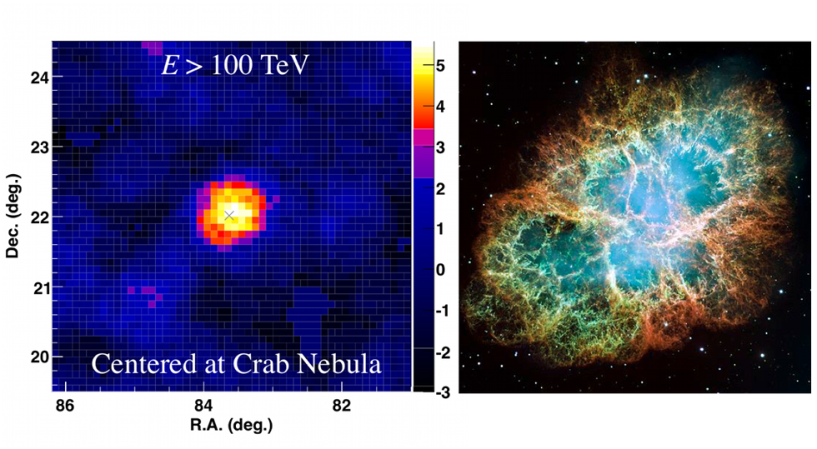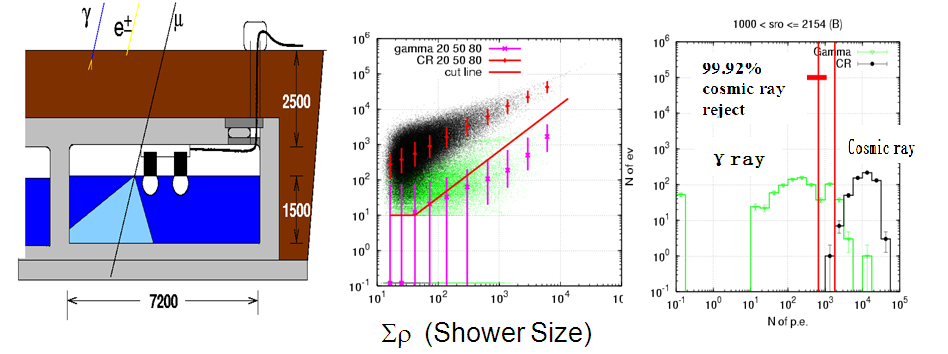
The Tibet ASgamma experiment, a China-Japan joint research project, has discovered the highest energy cosmic gamma rays ever observed from an astrophysical source – in this case, the "Crab Nebula". The experiment detected gamma rays ranging from > 100 Teraelectron volts (TeV) (see Fig.1) to about 450 TeV. Previously, the highest energy ever observed for a gamma-ray photon was 75 TeV, by the HEGRA Cherenkov telescope.
Researchers believe that those energetic gamma rays observed by the Tibet ASgamma experiment were produced by the interaction between very-high-energy electrons and the cosmic microwave background radiation (i.e., remnant radiation from the Big Bang).
The Crab Nebula is a famous supernova remnant in the constellation Taurus, powered by the embedded Crab pulsar that rotates 30 times per second. It was produced by a supernova explosion in 1054 AD (see Fig. 1), and was recorded in official histories of the Song dynasty in ancient China as well as in Meigetsuki, written by the 12th century Japanese poet Fujiwara no Teika. In the modern era, the Crab Nebula has been observed at all electromagnetic wavelengths ranging from radio to very high energy gamma rays.
The Tibet ASgamma experiment, located in the Yangbajing town of Tibet which has an altitude of 4300m above sea level, has been operating jointly by China and Japan since 1990. The China-Japan collaboration added new water-Cherenkov-type muon detectors under the existing cosmic-ray detectors in 2014 (see Fig. 2). These underground muon detectors suppress 99.92% of the cosmic-ray background noise (see Fig. 3) and thus improve the sensitivity significantly. As a result, 24 gamma-ray photons above 100 TeV have been detected from the Crab Nebula with low background noise. The highest energy is estimated as about 450 TeV (see Fig. 2).
Scientists hypothesize the following steps for generating very-high-energy gamma rays: (1) In the nebula, electrons are accelerated up to PeV, i.e., peta (one thousand trillion) electron volts; (2) The PeV electrons interact with the cosmic microwave background radiation (CMBR) that filling the whole universe; (3) A CMBR photon is kicked up to 450 TeVby a PeVelectron. The researchers thus conclude that the Crab Nebula is the most powerful natural electron accelerator known so far in our Galaxy.
This work opens a new window for the exploration of the extreme universe. The detection of gamma rays above 100 TeV is a key to understanding the origin of very-high-energy cosmic rays, which has been a mystery since their discovery in 1912. With further observations using this new window, we expect to identify the origin of cosmic rays in our galaxy, namely, PeVatrons, which accelerate cosmic rays up to PeV energies.
"This is the very first but a great step forward," said Prof. HUANG Jing, co-spokesperson for the Tibet ASgamma experiment. "It proves that our techniques worked well, and gamma rays with energies up to a few hundred TeV really exist. Our goal is to identify a lot of PeVatrons, which have not yet been discovered and are supposed to produce the highest-energy cosmic rays in our Galaxy."

Fig.1: The left figure shows the Tibet ASgamma detection of the highest energy gamma rays beyond 100 Teraelectron volts (TeV) from the Crab Nebula, the cross mark indicates the position of the Crab pulsar. The right figure shows the optical image of the Crab Nebula taken by the Hubble Space Telescope (Image by NASA).

Fig. 2 . The left figure shows the Tibet ASgamma experiment (Tibet-III array+ Muon Detector array); the right figure shows an event display of the observed 449TeV photon-like air shower. (Image by IHEP)

Fig. 3 The China-Japan collaboration placed new water-Cherenkov-type muon detectors under the existing cosmic-ray air-shower array in 2014. These underground muon detectorscan suppress 99.92% of cosmic-ray background noise. (Image by IHEP)

86-10-68597521 (day)
86-10-68597289 (night)

86-10-68511095 (day)
86-10-68512458 (night)

cas_en@cas.cn

52 Sanlihe Rd., Xicheng District,
Beijing, China (100864)

